When shopping for the best yoga mat to suit your needs, one of the first things you’ll have to decide is what type of mat surface you want. If you plan to use your mat primarily for hot yoga, or if you tend to perspire a lot, you’ll want a surface that has good gripping properties when wet. If you are practicing more seated positions and/or tend to stay dry during your yoga practice, then thickness, cushion, comfort, and support are the primary factors to consider.
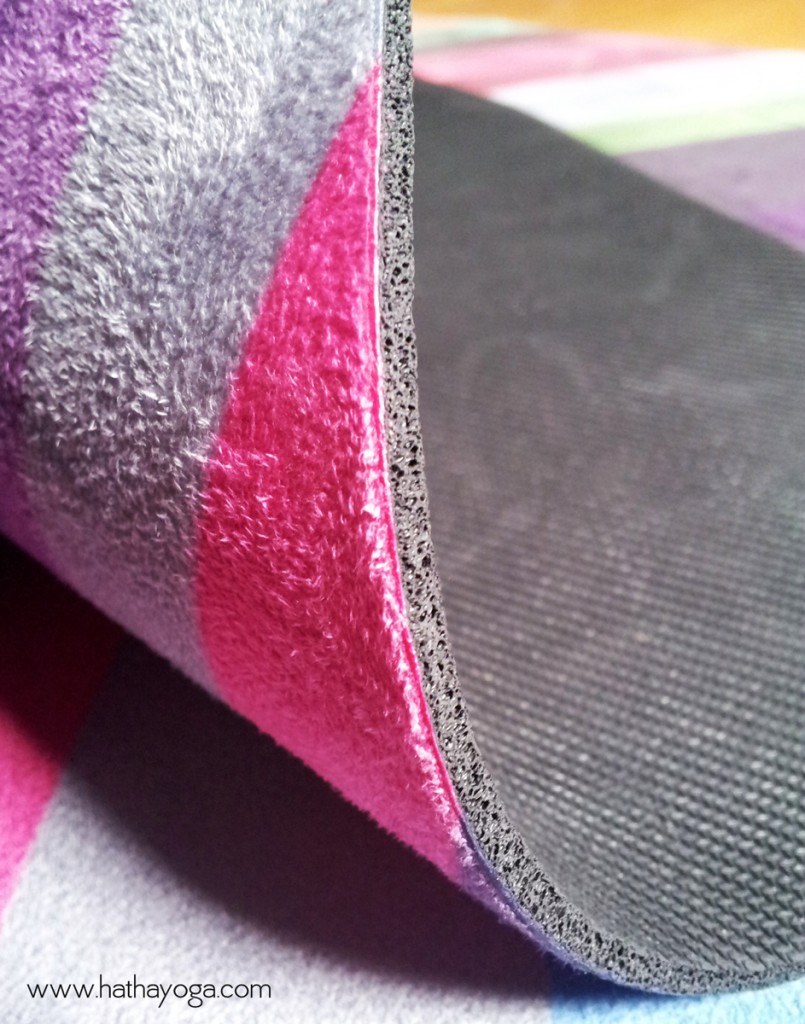
You may also want your mat to be non-toxic, environmentally friendly, and odor free. Other factors to consider are portability, durability, color, design, and of course price. Let’s start with an overview of each type.
Comfort, cushion, and stability
For most general yoga practice, if you don’t sweat a lot, then a classic yoga mat is best for you. Material and thickness will determine the levels of comfort and support that are optimal for your particular needs.
The main purpose of a yoga mat is to give cushion and traction. Thickness and material determine the amount of cushion. Traction allows you to balance while doing your poses. This is the “stickiness” of a mat.
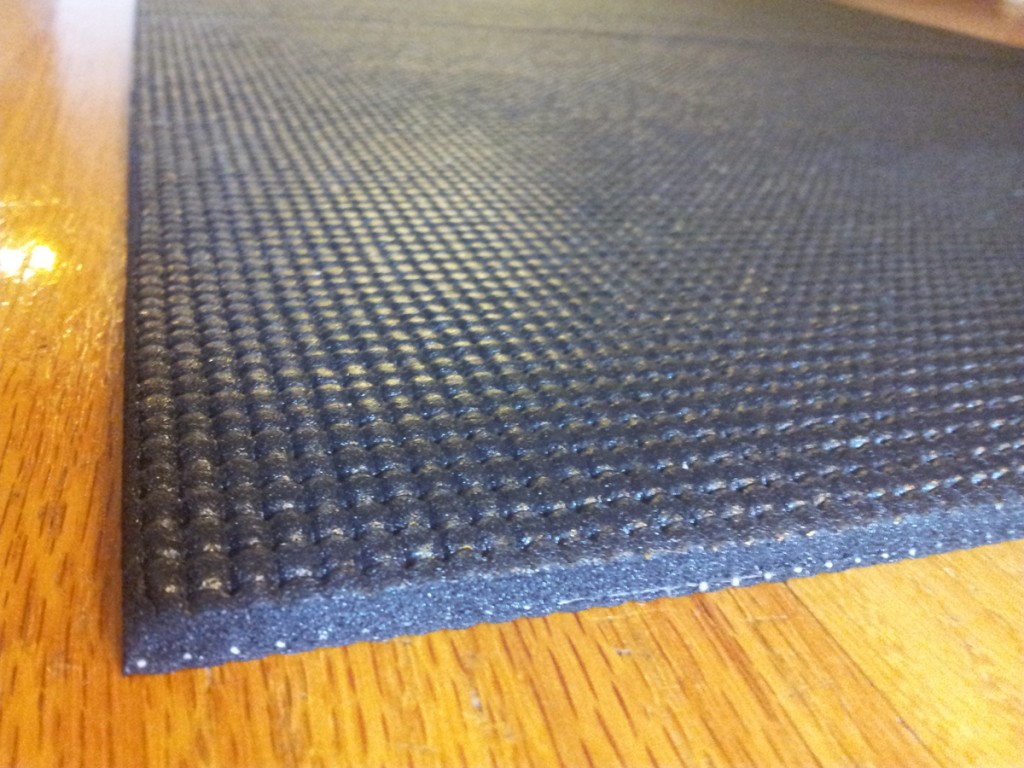
Thickness is critical since you want enough cushion to make you comfortable, but not so much that it interferes with your balance. Standard thickness mats strike a balance at around 1/4”. Extra cushioning mats can be a luxurious 1/2” thick. Thin, portable mats can be as thin as 1/16”. If you’ll be taking your mat to classes, you may also want to consider a sling harness or a carrying tote.
Here are a few of our favorite classic yoga mats. For a complete list check out our comprehensive guide here.
| Mat | Size | Cost | Weight | Colors | Material | Score |
|---|---|---|---|---|---|---|
BalanceFrom GoYoga 1/2" with Carrying Strap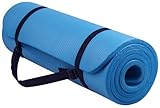 | 1/2" thick 71"x24" | $19.95 | 2.5 pounds | Black, purple, red, blue, green, pink, gray | Foam | 4.3 |
YogaAccessories 1/8'' Lightweight Classic Mat | 1/8" thick 68"x24" | $15.99 | 2.5 pounds | Black | Foam | 4.7 |
Gaiam Print Premium Yoga Mats (5mm) | 3/16" thick 68"x24" | $29.98 | 2.5 pounds | 17 design options | PVC. Free of phthalates and other toxins. | 4.2 |
Aurorae Classic Yoga Mat | 1/4" thick 72"x24" | $35.00 | 3.5 pounds | 12 options | Unknown material. Free of phthalates, silicone, latex, and toxins. Bio-degradable. SGS approved. | 4.6 |
Jade Harmony Professional 3/16-Inch Yoga Mat | 3/16" thick 68"x24" 74"x24" | $74.95 | 4.6 pounds | 9 options | Natural rubber. No PVC or ozone-depleting substances. | 4.6 |
Manduka PROlite Yoga Mat | 3/16" thick 71"x24" 79"x24" | $80.00 | 4.5 pounds | 14 options | Blend of polyester and eco-certified PVC. 100% Latex Free. | 4.2 |
Unless you are very tall, mat size is generally not an issue. Standard yoga mats are 24″ by 68″, which is the best yoga mat size for most people.
Not slippery when wet
If you’re pracitcing hot yoga, or if you just tend to sweat a lot, you’ll need a mat that can perform when wet. Some mats are specifically designed so that the grip improves the wetter it gets.
One variety that has been surging in popularity lately is the combo mat. Combo mats are comprised of a non-slip top surface fused to a more traditional yoga mat base which provides cushion. The best of both worlds!
All of the combo mats we’ve tried have performed extremely well when wet. Because of their construction, combo mats also lend themselves to interesting designs and materials. Some of them are among the best looking mats we’ve seen.
Here are a few examples of our favorite combo mats. For a complete list check out our comprehensive guide here.
| Mat | Size | Cost | Weight | Colors | Material | Score |
|---|---|---|---|---|---|---|
Yoga Design Lab combo mat | 1/8" thick 70"x24" | $68.00 | 4.1 pounds | 11 design options | Biodegradable natural tree rubber & microfiber | 4.6 |
Yoloha Cork Mat | 1/4" thick 72"x24" | $119.00 | 6 pounds | Natural cork | Natural cork surface, backed with domestic rubber from recycled tires. 100% recyclable. | 4.1 |
Aurorae Synergy Yoga Mat / Towel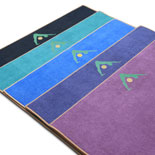 | 1/4" thick 72"x24" | $49.95 | 3.3 pounds | 5 options | Microfiber towel with PER backing. Free of latex, silicone and phthalates. SGS approved. | 4.7 |
While they have many positives, combo mats tend to be a bit more expensive than the average yoga mat. One way to get a similar level of performance is by using a yoga mat towel on top of an affordable yoga mat. Like a combo mat, this approach gives you a grippy surface when wet, combined with a cushioned foundation.
Material, stickiness and texture
Mat material determines stickiness, texture, sponginess (responsiveness to pressure), eco-friendliness, and durability. Stickiness is important since it’s what keeps you from slipping when practicing certain poses. Texture can either be by design, such as raised bumps, or it can be a feature of the material (such as jute mats, which are organically rough). Texture determines how comfortable the mat feels to touch, and can also affect how much traction a mat provides.
PVC is the most commonly available mat material because of it’s affordability and durability. PVC mats are generally the most sticky and spongy. Rubber, jute, and cotton mats are generally not as sticky as PVC, but can have surface texture that helps prevent slippage. Cork and combo mats are designed to be sticky when wet, but not necessarily when dry, so stickiness can be controlled by lightly spraying with water prior to use.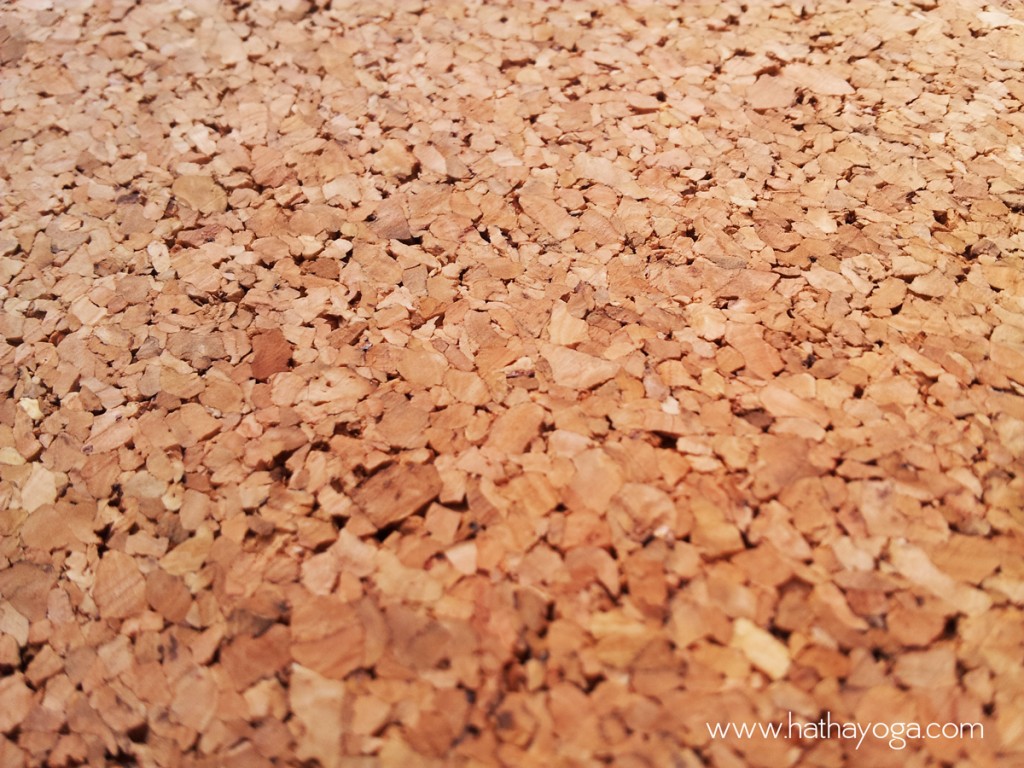
Eco-friendliness
Mats that are made from “foam”, or that don’t publicize what material they are made of, are most likely made from PVC. Generally mats that are not made from PVC prominently display what they’re made of as a selling point.
Not all PVC mats are created equally. Some are manufactured without phthalates and other toxins. However there are no PVC mats that are biodegradable.
Newer more eco-friendly options include recycled and natural rubber, organic or natural cotton, and jute. Rubber mats are the most popular eco-friendly option, but you should avoid rubber if you’re allergic to latex.
Cotton is the most absorbent mat material, which is important if you sweat a lot or plan to practice hot yoga. Cotton mats tend to cost a bit more, but are also available in a more affordable rug style. Jute mats feature an organic surface texture which prevents slippage naturally.
Here are a few of our favorite eco friendly mats. For a complete list check out our guide here.
| Mat | Size | Cost | Weight | Colors | Material | Score |
|---|---|---|---|---|---|---|
Yogasana Handmade Cotton Yoga Rug | 1/4" thick 72"x24" | $95.00 | 4 pounds | 5 color options | 100% Cotton | 4.4 |
prAna Indigena Natural Yoga Mat | 3/16" 78"x28" | $78.95 | 7.7 pounds | Plum, Azalea, Cove, Sail Blue | 100% Rubber | 3.8 |
Hugger Mugger Sattva Jute Mat | 1/8" thick 68"x24" | $36.84 | 2.7 pounds | Natural | Natural jute plant fiber with PER backing. | 4.2 |
Beware of mats with non-natural materials that make eco-friendly claims. Many companies use environmental issues as a marketing strategy, and claim products are eco-friendly when they really aren’t. If it’s not a material that grows in nature, it’s probably not very environmentally friendly.
Price
Last but not least, price matters. Cheap mats are easy to find at big box stores, but with yoga mats you tend to get what you pay for. Mats under $20 can wear out pretty quickly, and often have a chemical odor. Some of the best selling yoga mats are in the mid $20 range, if you don’t mind a PVC mat. Cost generally goes up with the quality of materials, construction, and eco-friendliness.
If you’re buying a mat online don’t forget to consider shipping costs. Many online retailers offer inexpensive or free shipping options on some of the best yoga mats out there. Also depending what state you live in, and what online store you’re buying from, shopping online can often save you sales tax.
Beginners kits
If you’re new to yoga, the best yoga mat for you may come in a beginners kit such as the Valeo Yoga Kit or the Sivan Essential Yoga 5 Piece Beginners Kit. Beginners kits are usually very competitively priced, and have extra accessories like blocks and straps which are used in many styles of yoga. The Gaiam Yoga for Beginners Kit even comes with a DVD with introductory workouts to get you started.
Cleaning and care
When you find your own best yoga mat it’s a good idea to wash it before you use it. This will remove any factory odors. Additionally, some new mats are slippery until you break them in, and washing will help with that.
Cleaning the mat after each use is important to help it last. It’s important to remove sweat and body oils, which can cause mats to deteriorate. Yoga mat cleaning sprays such as the Aurorae Organic Yoga Mat Wash can make clean up easy. You can also make your own at home, check out this fun video:
Don’t forget to store your mat in a cool place. Heat or direct sun can cause even the best yoga mats to age prematurely.
Finding the best yoga mat for you
Now that you have seen the options and reviewed our top picks for the best yoga mat on the market, its up to you to pick which one meets your needs in your price range.
New mats come on the market frequently, so we’ll update our guide as needed. But if you feel like we missed a superior mat that needs to be included on the list, or if you have your own tips on finding the best yoga mat, please let us know in the comments below. Namaste!:)

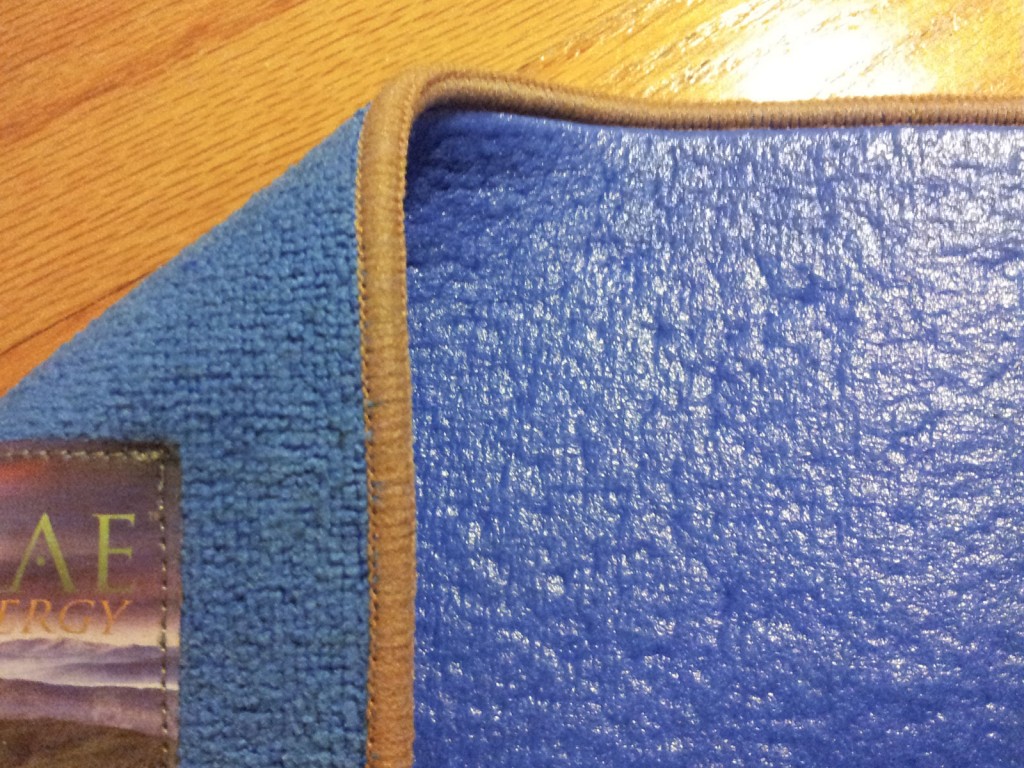
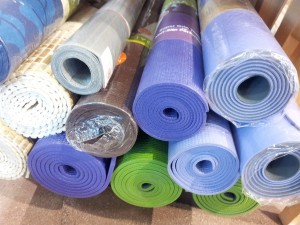
Hi there,
This site is fantastic but I would love to see the weight of the mats if at all possible?! I’m planning a long trip and would like to choose based on a combination of weight and comfort.
Many thanks,
Marissa
Hi Marissa- Thanks for the great suggestion. We’ve updated the chart accordingly, hope that’s helpful.
Howdy! Would you mind if I share your blog with my zynga group?
There’s a lot of folks that I think would really appreciate your content.
Please let me know. Thank you
Sure, no problem! Thanks and namaste.
I’m 58 years old. I have been doing yoga for a year. I recently went to the doctor’s for my knees. Apparently I have nothing behind my knee cap and he told me to keep up w/the yoga wearing knee support – but also a thicker mat. Is there one in particular that is better on knees?
Hi Molly,
The thickest mats we know about are the following: The Harbinger is 5/8 inch thick, people seem to like it. If you want to check it out click here.
The Spoga is also 5/8 inch thick and is is less expensive than the Harbinger. Click here for that one.
There are a number of 1/2 inch mats out there which you can look at in the chart above.
If you happen to come across any others, we’d love to learn about them!
Best wishes and namaste,
~Maria
Can you recommend a mat for people with flat feet?
Hi Enid, thanks for your great question. Fallen arches affect different people in different ways. One thing to consider is the amount of cushion. My thought would be that a mat with less cushion, such as a rubber mat, might give you more stability if stability is indeed an issue for you. If you find yourself slipping during yoga you’ll want a sticky mat. Definitely discuss your specific concern with an orthopedist or a physical therapist if you haven’t already. They might know what type of surface would be best for your specific condition. Also, I’m sure you know, but there are yoga exercises you can do for flat feet. Here’s a great article from Yoga Journal that might be useful for you. Thanks again for the question, Enid. I hope this was helpful!
I really appreciate the cleaning instructions and the comprehensive list of mats. I have a latex allergy, have tried the rubber mat and it is a no go for me. Tried a cotton mat, but it needs to be damp to really grip my hands and feet. In hot yoga class it dries up pretty quickly in the 90 + degree room, and I have slipping problems. Spritzing it with water midway through class is putting a kink in my flow! Tempted to try the hemp infused mat. Anyone have experience with that kind?
Also… Does it bother anyone else that when you roll up your mat, the side that was on the dirty floor, (where lots of bare feet have been walking across it) is then rolled up with the top side in contact with it? I have ben folding my mat in half, top side is only in contact with itself, and then rolling it up.
Thanks,
Christy
Sorry, meant to say jute infused mat!
Hi Christy,
Have you tried a yoga mat towel? Some have mini rubber nodules on the bottom to help it grip the mat (such as the Yogitoes brand), and others are made from microfiber which adheres nicely to a mat on its own (such as the Yoga Rat brand, see our review of it here).
And yes, I also feel the same way as you in regards to rolling up a mat and having the bottom side touch the top side. A yoga mat towel can also help with that since you won’t actually be touching the mat while you practice. Another solution to that problem would be to keep a thin regular towel to roll up with your mat so the bottom side of the mat never touches the top side. Of course that means you’ll have to find the right size regular towel.
Good luck Christy, and keep us posted on what solutions you find that work best for you!
Namaste,
~Maria
I think you need to find out whether it’s latex allergy because it’s the most natural material used today and the safest. It doesn’t decompose like artificial materials.
Hi everyone. Your post is amazing. This is like that I found everything in a single roof. Hey Maria will you please tell me Or advised me about Gym mats.
Thanks for the kind comment. Yoga mats are often used as fitness mats as well, so you can follow our yoga mat buying guide to find something that suits your preferences and budget. If you want something much thicker, there are also folding mats that are foam with a vinyl covering.
Hello! Which yogamat would you recommend for hot yoga? I was reading on the tomuno website and basically they stress the fact that there is no point to invest in an expensive yogamat since sweat breaks it down quickly and if you have a yoga towel, then the mat really doesn’t matter. Thanks!
Hi Jenny- We love yoga towels, especially for hot yoga (or for people who sweat a lot either way). Towels are great since they’re hygienic and super low maintenance, just throw them in the wash. And we agree, if you’re using a towel, it’s less critical what mat you’re using, as long as it provides enough cushion for you. We have more info on towels and compare options at our yoga towel comparison guide. Hope that’s helpful!
If a mat says it is made from A grade NBR foam (studio quality) is this toxic etc free?
Thank you.
Hi Emma- All NBR foam is from man made synthetic rubber. If you’re want to be sure your mat is non toxic and environmentally friendly, we recommend natural rubber, natural jute, or natural cork options.
People wanting to buy yoga mats must consider many things including their own body composition.
Giving scores is fine, but that should not influence the buyer too much. I hope that you bring out a more detailed chart telling what is good and what is bad in each mat.
All the best!
You are absolutely right, each person should find the features in a mat that work best for them. When reading our chart, in addition to the ratings, it is important to look at the size of the mat, the thickness, the materials, the weight and the price, all of which are listed. Also we strongly recommend reading the reviews of any mat you’re interested in, which will give you an overall sense of what other individuals like and dislike about any particular mat. It is also important to choose a mat based on the type of yoga you practice. From time to time we do in-depth reviews of specific mats, so you can look for those on our site as well. Thanks!
I need a non-slip mat for piyo class. thanks
Hi Cheryl, there are three mats we reviewed that might suit your PiYo needs:
1.) http://hathayoga.com/yoga-design-lab-combo-mat-review/
2.) http://hathayoga.com/cork-yoga-mat-by-yoloha-review/
3.) http://hathayoga.com/yoga-mat-towel/
Hopefully one of them will work for you!
I’ve been looking for a larger, square mat in 1/2″ thickness, but can’t seem to find one. Any tips?
Hi Lauren,
We don’t know of any large, 1/2 thick, square yoga mats. But one thing you could consider, if this is for home yoga or if you plan to keep the mat generally in one place, is foam/mat flooring that comes in square, interlocking tiles that fit snugly together. With these you can make the mat as large as you’d like. If you do consider this, just be sure the materials are suitable to you and the type of yoga you practice. This would probably not be ideal to regularly bring to class, but it’s not impossible. Hope this is helpful, Lauren!
Namaste
Thank you, Ayal!
Hi I am wondering, do PVC mats contain latex?
Hi Aaron- It depends what you mean by latex, as described here. Mats made with natural rubber will have latex. PVC mats are made from synthetic materials. If you have health concerns, perhaps you could try a mat made with natural fibers such as jute, cotton or cork. If you are highly allergic to latex, keep in mind that many cork mats have a natural rubber base. However, your body will not be in contact with that side since it’s strictly on the floor side.
Hi!
I practice my yoga in different places, mostly indoors. I do not sweat much when I practice. I need a mat that will not slip on a hard wood floor and carpeting. Also, i use rubber gripitz for my wrists, which look like large weights. I have found the gripitz to slip at times. What would be the best mat top to use to prevent slippage? Rubber, suede, jute, etc??
Hi Susan- I think if you do not perspire very much, a rubber mat might be the best match for you. It is a natural material, and will not slip on a hardwood floor. I don’t believe it would slip on carpeting, but use extra caution when using a mat on high pile carpet, as you want to be sure to keep proper balance.
Thanks for question, Susan!
Namaste, Maria
HathaYoga.com
Hi,
One of the problems that I’m finding with some of the yoga mats, especially the thicker or cheaper ones, is that they stretch. This bothers me in lunges and other postures where your legs are far apart and are pushing in opposite directions.
Can you recommend a yoga mat that does not stretch, but is reasonably priced?
Hi, and thanks for the question. Perhaps a natural rubber work might work better for you than one made from synthetic materials. Right now Prana has their Indigena Natural Yoga Mat on sale on their website for $39.50 (usually $79) in case that interests you. Either way, a rubber mat might be the way to go, as they are often more solid than cushioned mats. Hope that helps!
Hi, i have been using the mat for about 8 months now and as advised i have been cleaning it daily after use but the mat has turned even more slippery now… What can i do for it??
Hi Nikita, It really depends on the material of your specific mat. But generally, a yoga mat towel should help with slippage.